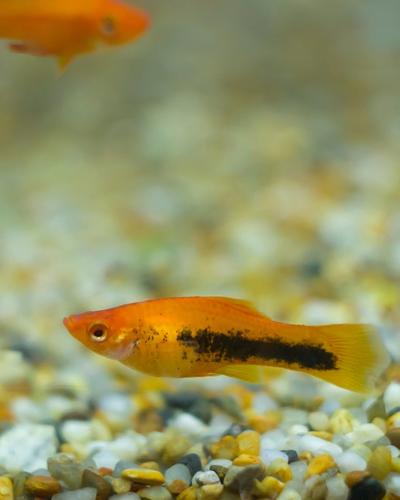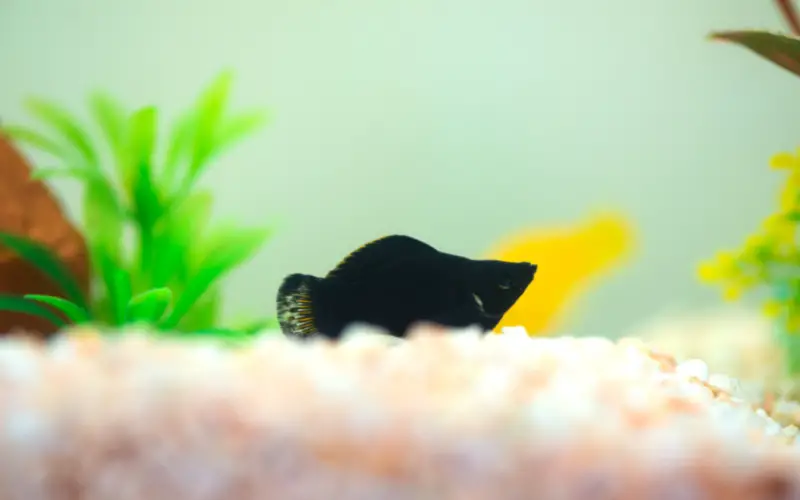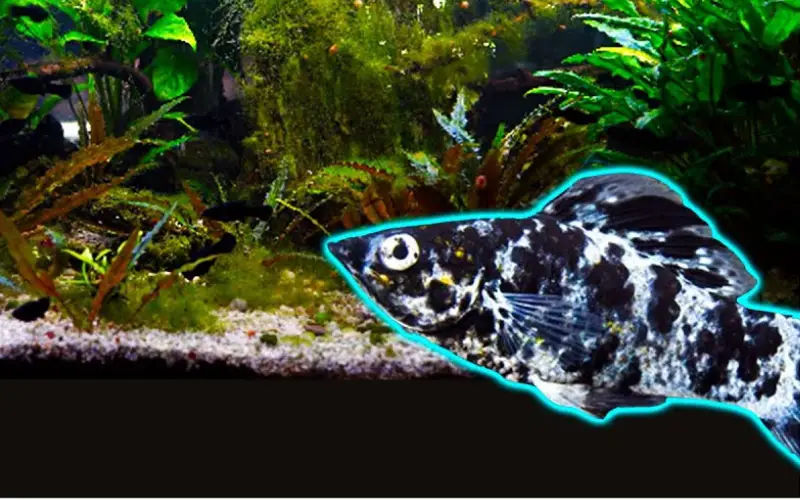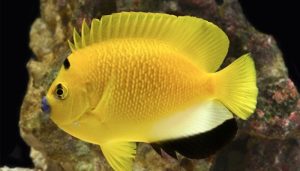Do molly fish sleep on bottom of tank, and why are my mollies at the top of the tank? Molly fish are a common fish species that require special consideration, especially regarding their sleeping habits.
Many aquarium owners wonder if Molly fish sleep on the bottom of the tank and, if so, what causes it and what to do if your fish is laying on the bottom.
Why do molly fish stay at the bottom of the tank? With requisite knowledge and care from their owners, these unique freshwater fish can thrive in any home aquarium.

So, do fish sleep at bottom of tank, and why is my molly laying at the bottom of the tank?
In this blog post, you will learn about why some Molly fishes choose to sleep on the bottom, how do molly fish sleep and five potential causes and solutions for preventing this behavior.
Table of Contents
ToggleIs My Molly Fish Sleeping or Dead?
Why are my mollies at the top of the tank? Determining whether a fish sleeping on bottom of tank or dead can sometimes be challenging, but there are a few signs you can look for to make an assessment.
Why does molly fish staying in one spot? Here are some indications to help you determine the status of your Molly fish:
- Movement: Observe if your Molly fish is showing any signs of movement. A sleeping fish may still exhibit slight movements, such as twitching or fin adjustments, while a dead fish would likely be motionless.
- Breathing: Watch for gill movement. Living fish will continue to breathe, and you should observe their gills gently opening and closing. If there are no visible signs of gill movement, it could indicate that the fish has passed away.
- Response to external stimuli: Gently tap the aquarium or make some noise near it. A sleeping fish may display a response, such as a change in position or swimming away slightly. If there is no reaction, it could suggest that the fish is deceased.
- Coloration and physical appearance: Examine the Molly fish for any changes in color or overall appearance. If the fish appears pale, discolored, or has any signs of deterioration, it could indicate that it has died.
It’s important to note that Molly fish are known to rest at the bottom or in secluded areas, especially during the night or when they feel stressed. They may remain immobile for extended periods, resembling a sleeping state.
However, if you have concerns about the health of your fish, it’s best to observe them closely and, if necessary, consult a knowledgeable aquarium specialist or veterinarian for a more accurate assessment.
Do Molly Fish Sleep on Bottom of Tank?
Do mollies sleep on the bottom? Yes, Molly Fish can sleep on the bottom of their tank. While some may choose to rest at the top or middle of the tank, many Molly Fish will stay at the bottom due to health concerns like swim bladder infections, ich, or pregnancy.
Additionally, depending on water temperature and oxygen levels in the molly tank, they may opt for resting periods on the floor as it is typically cooler and oxygen-rich here.
Where Do Mollies Sleep?
Molly Fish can sleep in various places within the tank. While some drift around, others might molly fish stay near the bottom. If the Molly Fish feels stressed or ill, it will most likely seek out the bottom of the tank to sleep and rest.
Also, if there is not enough oxygen in the upper levels of the tank, it may head to the bottom, where it is better oxygenated.
Finally, if the water temperature gets too high in their tank, Molly Fish may opt for sleeping on the cooler bottom.
How Can You Tell If a Molly Fish Is Sleeping?
How do fish sleep in a tank? You can tell if a Molly Fish is sleeping by observing their behavior. They will lie motionless at the bottom or near the water’s surface.

When awake and active, they will swim around searching for food or exploring their environment. Also, look for signs like closed eyes, slow movements, and a relaxed demeanor.
Do Fish Sink to the Bottom When They Sleep?
Fish of many varieties have an interesting behavior while resting: they sink to the bottom! This sleep position is seen in popular species such as bettas, tetras, and goldfish. Tiger barbs, guppies, and danios – allowing them a peaceful slumber undisturbed by their aquatic neighbors.
There are a few reasons why fish sleep on the bottom, primarily related to temperature and oxygen levels in the water.
What Does a Sleeping Molly Fish Looks Like?
In the case of Mollies, the sleeping condition often resembles an awaking dream state.
Some species nest within the bottom part of their water body, and others hover around the bottom, but they can’t get near their bodies to the surface.
Several sleeping molly fish have also been described as unmoving, mainly because of the constant movement.
Sometimes species can be asleep and will not be conscious of their presence when it is going to take place in the ocean.
Do Molly Fish Sleep Upside Down?
How do mollies sleep? Molly fish do not sleep in normal conditions. If you notice your molly fish sleeping there, you should check its health status because something is wrong.
However, if the fish is sleeping upside down, it can cause swimming bladder disease that can prevent them from maintaining weight or controlling the movement of their bodies.
In this case, you should treat the fish aquarium and check if any other symptom could be causing this fish’s behavior.
How Long Does a Molly Fish Sleep
Molly Fish usually sleep for 6 to 12 hours at night, depending on the aquarium light and temperature in their environment. During the day, they tend to rest or hide in the substrate.
In general, fish require a dark place to rest, and since mollies can be quite active during feeding time, it is not uncommon for them to take short nap breaks throughout the day.
Why Is My Molly Laying at the Bottom of the Tank?
Why is my molly fish sitting at the bottom of the tank? Mollies are one of the most popular aquarium fish, but many people don’t know why their molly is laying at the bottom of the tank.
When a molly lays at the bottom of the tank, it can be concerning for aquarium owners. There are several reasons why this might happen, and it’s important to identify the cause to provide the appropriate solution.
Below we will outline five common reasons why your molly sleeping on the bottom of the tank. We will also provide solutions for each reason so you can get your molly back to swimming happily in no time!
5 Reasons Why Do Mollies Sleep on the Bottom
Why do mollies sleep at the bottom of the tank? Here are Five Potential Causes and Solutions for molly sitting on bottom of tank:
1. Swim Bladder Disease
During a swim, swollen intestines can be affected. The bladder of the swimmer’s body can be critical to their ability for balance during their swims through the water.
Factors such as excessive ingestion and constipation are likely causing mollusk bowel movements to swell up and debilitate its operation. Infections caused by bacteria could cause it.
Swim bladder problems are preventable by the Mollyfish’s ability to swim. Depending on how many tanks are in operation, some might go from one place to another, swim erratically, or linger on the bottom.
Solution: The best way to cure the swim bladder disease is to give your molly fish an Epsom salt bath using 1 teaspoon per gallon of water. This Epsom salt bath can help reduce inflammation and relieve the pain caused by swim bladder disease.
2. Stressful Conditions
Some factors can cause stress on the mobs. These include bad water conditions, dangerous tank mates, and new environments. Sometimes fish suffer from disorientation once introduced to the tank.
Others might be negatively affected by unexpected light changes and decorative changes. The reaction may lead to them seeking refuge beneath the sink. It would happen to anyone who had recently changed his aquarium.
Solution: To reduce stress, start by testing the water parameters such as pH, Nitrites, Ammonia, and Nitrates. Please make sure they are all at safe levels. If needed, do a water change to reduce the nitrate and ammonia levels in the tank.
Once the water is in a safe environment, it’s time to create some hiding spots in the tank, such as plants and caves. This will give stressed mollies a place.
3. Inappropriate Temperature
Temperatures above optimum temperatures can cause pain in fish. Cold water holds a lesser amount of oxygen. Temperature rise can cause oxygen deficiency. This obliges a couple of fish to find shelter in a higher tank.
However, there is a possibility of warm water rising if temperatures spike. Those layers create cold, oxygen-filled water below. Molly fish is looking at this section of the tanks as an escape route.
Solution: The ideal temperature for mollies should be between 74°F and 80°F. You should adjust the temperature accordingly if the water is too cold or too hot. Depending on the current water temperature, you can do this by using an aquarium heater or a cooling fan.
4. Poor Water Conditions
A poorly stocked tank can get your Molly fish in a hole. Nitrogen is poisonous for eluding fish. You may need more tests, but you need a more accurate test.
It may be that ammonia is the culprit for these colors. You may see crimson streaks in the fins slowly. It’s far superior if there’s a test kit for water.
Solutions: Test the water parameters such as pH, Nitrites, Ammonia, and Nitrates using an accurate aquarium test kit. If ammonia or nitrite levels are high, do a water change to reduce the levels in the tank. A dirty tank can make your fish sick. If possible, use an aquarium filter and an air stone to help keep the water clean and safe.
5. High Ammonia Levels
Depending on the amount of ammonium in your tank, the mollies will attempt to run up and avoid discomfort. Similar effects occur when nitrite and nitrate concentrations increase. As I said, regularly testing the water for toxins is advisable. The water testing kit should help. You’ll also notice a recurring problem in behavior that your fish present.
Solutions: To reduce ammonia levels, make regular water changes and ensure that you are not overstocking the tank. Feed your fish correctly, and don’t overfeed. Make sure that your filter is cleaned and maintained regularly. Use aquarium chemicals to remove the ammonia from the water.
6. Poor Food Resources
The fish eat their food, and then they go to the tank. They are aware that most fish of what they eat is from above. Therefore, the scouts are going to visit the region hoping for food. So the food is kept there until the problem has been resolved.
That could be true when mollies have left their upper portions before feeding. It’s ok. They can go back to the top section and find a meal. Often your fish is too big to eat. Try giving the child a daily dose for at least a few minutes.
Solutions: Make sure you are feeding your mollies the right food. It would be best to look for foods with high-quality proteins and vitamins. It would help if you also fed your mollies small amounts of food several times daily. Avoid overfeeding and make sure that all uneaten food is removed from the tank immediately.
Add supplementary food sources such as algae tablets and frozen or live foods to the diet. This will give your pregnant mollies the nutrients they need to stay healthy.
Is It Normal for Fish to Sleep on the Bottom?
Why does my molly fish lay at the bottom of the tank? Many types of fish can rest on the bottom of the tank. This behavior is completely normal and helps to conserve energy. Fish need a safe and comfortable place to rest, and the bottom of the tank may provide that.
If you find a sleeping fish, It is unnecessary to take action if your molly fish is sleeping at the bottom of the tank.
However, it ensures plenty of hiding places in the aquarium for them to hide or take refuge from any potential predators.
How Can You Tell If Molly Fish Are Stressed?
Molly fish are very sensitive to changes in their environment and can become easily stressed. If they’re swimming in circles, dashed to the bottom, or sticking close to gravel and rocks – it could be a sign that something’s up. Fret not!
Your fish might need extra TLC – watch for signs of distress like fin-locking and take steps towards relieving their anxiety.
Solution: Check the water quality parameters of the tank. Carry out regular water changes, keep an eye on the temperature, and ensure that your Molly fish get enough oxygen.
Provide plenty of hiding places in the tank for them to escape from potential predators. Lastly, add some aquarium salt to reduce stress levels in molly fish.
Can Molly Fish Have a Sleeping Disorder?
Firstly, molly fish have no regular sleeping schedule, especially when female molly fish babies are born or when spawning or migration occurs.
Upon migration of the molly fish into varying environments, the molly first adapts themselves to the changing environmental conditions. It could affect their sleep patterns in the future. Besides, a small number of fish have sleep problems.
A few fish also develop insomnia, which means they cannot sleep for longer than usual while they sleep. In time, they return to their previous states quickly. They return to sleep in normal conditions.
Where Do Mollies Swim in the Tank?
Mollies will typically swim in the middle and upper parts of the fish tank. They like to be up close to the surface, where oxygen levels are higher, and there are lots of light for them to see.
Mollies also like to explore the sides and corners of the tank, as they are curious creatures and want to explore their environment. They may even come close to the side of the separate tank, where they can see you.
Provide plenty of driftwood and rocks in your aquarium for them to hide behind or swim around. This will give your mollies places to explore and hide when they feel stressed or overwhelmed.
Molly fish maintained in aquariums rely on the interior lighting to determine when they catch theirs z’s. As such, proper light management is crucial for a healthy sleep cycle!
Overall, molly fish like to stay in the middle to the top of the water, with plenty of aquarium lights and oxygen for them to thrive in.
How to Tell If a Molly Fish Is Dying?
Why does molly fish laying on bottom of tank breathing heavy? Molly fish laying on the bottom of the tank, breathing heavily, not eating, and having clamped fins could be a sign that it is sick or even dying.
These are common signs of stress, illness, or even death. Other signs of a dying molly may include:
- Yellowing or discolored fins.
- White spots on the body.
- Any other signs of distress.
If you notice any of thesedead fish signs in your molly, it is important to check the water quality parameters and take steps to improve the overall health of your fish.
Is It Normal for Mollies to Lay at the Bottom of the Tank?
Yes, it is normal for mollies to lay at the bottom of their tank. This behavior can be attributed to a few reasons, such as spawning or hiding away from other fish in the tank.
As long as ample swimming areas, hiding spots, and plants in the tank provide cover, your molly should feel safe enough to stay settled on the bottom.
Additionally, some Mollies may prefer resting on the ground due to their anatomy – they have a dorsal fin that prevents them from comfortably floating higher up in the water column as most other fish would.
Do Mollies Sleep at the Top of the Tank?
Yes, mollies do typically sleep on the top of the tank. This molly fish sleep behavior is believed to be an evolutionary adaptation, as it allows mollies to look better for predators or food sources in their environment.
Mollies are also surface-dwellers by nature and often rise to the top of the water during daylight hours in search of food particles that may have collected there. Wildlife experts have observed this behavior in both wild and captive-bred mollies alike.
Why Is My Molly Fish Staying at the Top of the Tank?
Why is my molly sitting at the bottom of the tank? Pregnant molly molly fish staying in one spot at bottom of tank is a common behavior that can be attributed to several causes.
Pregnant molly fish, for example, may stay at the top of their tank to avoid being chased or harassed by other tank mates in the aquarium.
Female mollies may also stay near the surface if they feel stressed or overwhelmed. This behavior is often seen when the water temperatures and quality in the tank are not ideal.
Do Black Mollies Sleep on the Bottom?
Yes, black mollies do sleep on the bottom. Nocturnal fish typically use their dorsal fins to rest peacefully against the substrate during the day.
Due to their tendency to hide in dark spots, they tend to seek out corners in the tank where they will stay for long periods. During this resting period, it’s not uncommon for them to find comfort by sleeping on the floor of their aquariums.
Why Is My Male Molly Sitting at the Bottom of the Tank?
Why is my molly fish sitting at the bottom of the tank? There are a few potential causes for a male molly sitting at the bottom of its tank, including stress, illness, or old age.
Stress can be caused by poor water conditions (such as high levels of toxins or other pollutants), overcrowding, incompatible tankmates, and sudden environmental changes such as temperature swings.

Illness can cause lethargy and lack of activity that may result in the fish remaining close to the substrate. Old age can also lead to decreased activity, which may affect your molly fish’s decision to remain at the bottom of the tank.
It is important to check your molly’s sleeping behavior and look for signs of sickness, such as loss of appetite, pale or discolored fins/gills, clamped fins, or any unusual excrement. To help determine the cause,
In some cases, it could also be due to aggression from other fish in its surroundings, so you should inspect any aggressive fish if this is a suspected cause.
Why Is My Molly Fish Laying on Its Side at the Bottom of the Tank?
Why do molly fish stay at the bottom of the tank? There can be several reasons why molly fish laying on side at bottom of tank. The most common causes are related to poor water quality, illness or injury, stress, lack of oxygen, and/or swim bladder disorder.
Ensure that you have a well-maintained aquarium with regular water changes, check for signs of disease or wounds in the fish, and monitor the tank for signs of stressed behavior by other inhabitants.
If none of these seem to be causing this behavior, consider researching possible swim bladder disorder symptoms, as this is fairly common amongst certain species like Mollies.
Why Is My Balloon Molly Sitting at the Bottom of the Tank?
Why does my molly fish is sitting at the bottom of the tank? Balloon molly laying on bottom of tank can be caused by various factors, including poor water quality, stress from other tankmates or environmental changes, and even swim bladder disorder.
To prevent this, ensure that the tank is cleaned regularly and the water quality remains stable. Also, introduce new fish slowly and watch for signs of aggression or stress in other tankmates.
If your freshwater fish continues to lay at the bottom of the tank, research swims bladder disorder and its symptoms to ensure that it is not suffering from this condition.
Do Molly Fish Have Eyelids?
Molly fish lacks eyelids, but they do have the ability to close their eyes. This is an adaptation that helps them get through dark spaces and navigate murky waters with ease.
Their eyes are covered with a thin membrane that helps protect them from debris and other objects in the water. This membrane is not thick enough to act as an eyelid, but it is enough to provide them with protection and some level of visibility.
Overall, molly fish do not have eyelids, but they can close their eyes to protect them from any potential harm.
Commonly Asked Questions about Molly Fish Stuck at Bottom of Tank (FAQs)
How do molly fish sleep?
How does a molly fish sleep? Molly fish don’t have eyelids, so they can’t truly close their eyes. Instead, they become less active at night, resting near the bottom or plants. Look for slow movements and breathing.
Why is my molly fish staying at the bottom of the tank?
There are several reasons your molly fish staying at bottom of tank. It could be stressed, sick, or unhappy with the water conditions.
Why is my Molly fish laying at bottom of tank still breathing?
Why is my molly fish laying on the bottom of the tank? There are several reasons your Molly might be lethargic. Check water quality (ammonia, nitrites) and tank temperature. Disease or tankmates bullying are also possibilities.
Why does my molly fish swimming sideways?
Why molly fish swimming at bottom of tank? Sideways swimming in mollies often points to swim bladder disease. This can be caused by overfeeding, poor water quality, or internal injuries.
Is it Normal for new fish laying on bottom of tank?
Yes, new fish sometimes rest on the tank bottom while adapting to their new environment. However, watch for other signs of stress or illness like labored breathing or lack of eating. If you see those, further investigate.
Why is my molly fish hiding?
Why is my molly staying at the bottom of the tank? There are a few reasons your molly might be hiding: new tank jitters, poor water quality, tank mates bullying or feeling unsafe.
Why is my fish laying at the bottom of the tank on its side?
There are several reasons why your fish might be lethargic and lying on its side. It could be swim bladder disease, poor water quality, or stress.
Will pregnant molly staying at bottom of tank?
Why is my pregnant molly sitting at the bottom of the tank? Yes, pregnant mollies often stay near the bottom of the tank seeking hiding spots or preparing for birth.
Why are my mollies laying on the bottom?
Mollies resting on the bottom can be normal, but it could also signal stress, illness, or water quality issues. Observe their behavior for signs of trouble.
Why does my molly stay at the bottom of the tank?
A molly staying at the bottom of the tank could indicate illness, stress, poor water quality, or pregnancy. Observe for other signs and consult a veterinarian if concerned.
Conclusion
So, why do molly fish stay at the bottom of the tank? When it comes to molly fish sitting at bottom of tank, Molly Fish are like any other living creature on earth and need their beauty sleep. But the question remains, do molly fish sleep on bottom of tank? The answer may not be as cut and dry as you think. If you have a Molly Fish, keep an eye on them at night to see where they end up sleeping. If your molly fish is sleeping on the bottom of the tank, there could be several reasons. Luckily, no matter the cause, there is always a solution to help the fish keeper’s little friend live a happy and healthy life back at the top of the tank!
You might also like
- Why Do Molly Fish Laying on Bottom of Tank? (5 Causes Solved)
- Where Do Mollies Swim in the Tank? (7 Sick Fish Signs & molly fish at bottom of tank Cure)
- How to Tell If a Molly Fish Is Dying? (5 Fish Sick Symptoms)
- What to Feed Molly Fish? A Definitive Guide (For Beginners)
- Molly Fish Pregnancy Cycle: A Complete Breeding (Guide)
- Bloated Molly Fish: Reasons + 3 Early Warning Signs of Dropsy
- How Big Can a Black Molly Fish Get: (The Ultimate Guide)
- Are Black Mollies Bottom Feeders: (The Shocking Truth)
- Are Black Molly Fish Nocturnal Creatures: (Myths & Facts)




